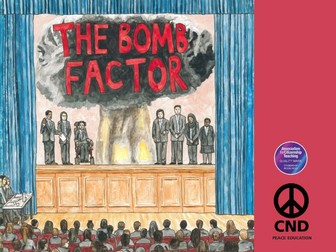The Bomb Factor
ABOUT:
Exploring the nuclear weapons debate in the style of The X Factor!
In small groups, students take on the role of different countries/organisations, either for or against nuclear weapons. They create a performance or presentation to convey the arguments. A panel of student judges decides which group is the most original and persuasive, and then the class votes for or against nuclear weapons based on the evidence heard.
This student-led activity develops a range of different skills, and makes this controversial debate engaging, accessible and fun.
Watch a video of The Bomb Factor in action at Hessle High School: www.tes.co.uk/teaching-resource/The-Bomb-Factor-Nuclear-Weapons-6084482/
The lesson - and the teaching pack it comes from - is highly relevant to the curriculum and exam syllabuses of English, Citizenship, History, RE, and several other subjects. It is also an excellent way to help meet SMSC, British Values, and Prevent requirements.
You can download the other activities from the Bomb Factor pack, or the pack as a whole, below.
PRAISE:
‘The idea of making presentations is usually met with resistance by pupils in the classroom. But Bomb Factor lets their creative juices flow as they get to grips with a powerful issue. The lesson can captivate a restless class and it’s great for pupils who like to learn on their feet. There’s no time for fidgeting or boredom here.’ - TES
‘‘The Bomb Factor’ is a useful resource for citizenship teachers. It provides a range of arguments surrounding the controversial issues of the proliferation of nuclear weapons and the use of nuclear power. It promotes critical investigation, debate and discussion and develops pupil’s skills for dealing with differing opinions in the classroom.’ - Association for Citizenship Teaching’s Quality Mark assessment panel (the pack was awarded the Quality Mark!)
‘Fun, interesting and engaging. The best kind of session.’ – two Year 10 students, The Hamble School, Southampton
‘There was a buzz about the ‘Bomb Factor’… The staff and students were impressed by the informative but balanced views’ - RE teacher, Sturminster Newton High School, Dorset

